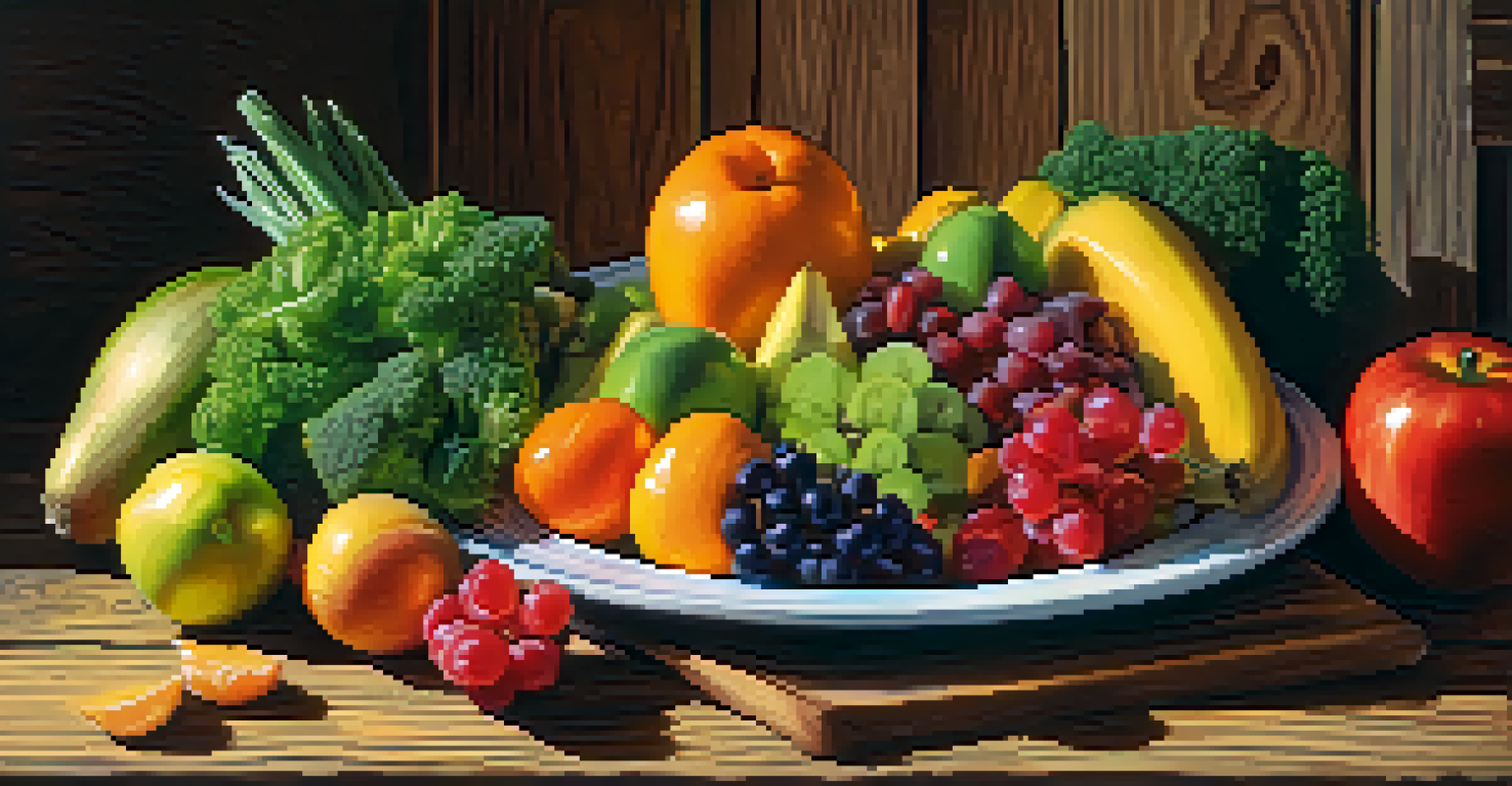Enhancing Your Raw Food Experience with Mindfulness

What is Mindfulness and Why It Matters
Mindfulness is the practice of being fully present and engaged in the moment. It encourages us to observe our thoughts and feelings without judgment, fostering a deeper connection with our experiences. In the context of food, mindfulness can significantly enhance how we perceive and enjoy our meals.
Mindfulness isn't difficult. What's difficult is to remember to be mindful.
When applied to raw food eating, mindfulness helps us appreciate the vibrant colors, textures, and tastes of fresh fruits and vegetables. This awareness transforms eating from a mundane task into a sensory adventure. It's like savoring a fine wine, where every note and aroma can transport you to another place.
By incorporating mindfulness into your raw food experience, you not only nourish your body but also cultivate a sense of gratitude for the food you consume. This practice encourages a healthier relationship with food, making each meal a moment of joy and connection.
Setting the Stage for Mindful Eating
Creating the right environment is key to fostering mindfulness during meals. Choose a quiet space, free from distractions like phones or television, where you can focus entirely on your food. A simple, clean table setting can also enhance the dining experience, inviting you to be present.

Consider dimming the lights or lighting a candle to create a calming ambiance. This sensory element can help you relax and prepare your mind for the meal ahead. Think of it as setting the stage for a performance; the atmosphere prepares you for the main event—your delicious raw meal.
Mindfulness Transforms Eating
Practicing mindfulness during meals enhances our appreciation of food, turning eating into a sensory adventure.
Remember, the goal is to engage all your senses, so consider playing soft music or even incorporating aromatic herbs into your meal preparation. These small changes can elevate your eating experience, making it more enjoyable and mindful.
Engaging Your Senses with Raw Foods
Raw foods are not just about nutrition; they offer a unique opportunity to engage your senses. Take a moment to observe the vibrant colors of your ingredients, from deep greens to bright reds. This visual appeal can enhance your anticipation and enjoyment of the meal.
Eating is a necessity, but cooking is an art.
Next, consider the textures of your food. From the crunch of fresh vegetables to the smoothness of a nut-based spread, varying textures can create a delightful experience. Engaging with these sensations can feel like a mini-exploration of nature on your plate.
Finally, pay attention to the aromas that waft from your meal. Each scent tells a story, evoking memories or sparking curiosity. In this way, raw foods become not just sustenance but an invitation to explore and enjoy the world around you.
Mindful Preparation: Cooking with Intention
Mindfulness doesn’t just start when you sit down to eat; it begins in the kitchen. As you prepare your raw meals, focus on the process rather than rushing through it. Take your time to chop, mix, and arrange your ingredients with care, appreciating each step.
This intentionality transforms cooking into a meditative practice. Think of it as a form of art therapy; each slice and stir becomes an expression of creativity and self-care. You might even find that the act of preparing your food brings you joy and satisfaction.
Create a Mindful Eating Environment
Setting a calm and distraction-free environment elevates the dining experience, allowing for full engagement with your meal.
By being present during the preparation process, you set a positive tone for the meal. This mindfulness can lead to healthier choices and a deeper connection with the food you consume, making every bite more meaningful.
Savoring Each Bite: The Art of Slow Eating
Once your meal is ready, it's time to dive in—but remember to take it slow. Savoring each bite allows you to truly appreciate the flavors and textures of your food. Chewing thoroughly not only aids digestion but also enhances your tasting experience.
Try to eliminate any distractions during this time. Instead of multitasking, focus solely on your meal. This practice can feel like a mini-retreat, where each bite becomes a moment of mindfulness and gratitude.
As you eat slowly, notice how your body responds. Are you feeling satisfied? Are there flavors that excite you? This awareness helps you tune into your body's hunger cues, promoting a healthier relationship with food.
Cultivating Gratitude for Your Food
Gratitude plays a significant role in enhancing your raw food experience. Before you begin your meal, take a moment to reflect on where your food comes from. Acknowledging the farmers, the earth, and the resources that brought your meal to your table can deepen your appreciation.
Consider keeping a gratitude journal where you jot down what you’re thankful for regarding your food. This practice can help you focus on the positive aspects of your eating habits and create a more fulfilling experience.
Savor and Appreciate Each Bite
Eating slowly and with intention helps cultivate a deeper connection with food and promotes a healthier relationship with eating.
Expressing gratitude can also enhance mindfulness during meals. When you appreciate your food, it transforms each bite into a celebration, making your raw food journey not just about nutrition but also about joy and fulfillment.
Sharing Your Raw Food Journey Mindfully
Sharing meals with others can enhance the mindfulness experience, creating a sense of community and connection. When you invite others to join you in your raw food journey, it opens up opportunities for shared experiences and conversations about health and wellness.
Engage your guests in the process—invite them to help prepare or choose ingredients together. This collaborative approach can enhance everyone's connection to the meal and promote mindfulness among all participants.

As you share your raw food experiences, consider discussing the principles of mindfulness that enhance your enjoyment. This can inspire others to incorporate mindfulness into their own meals, spreading the joy of mindful eating far and wide.